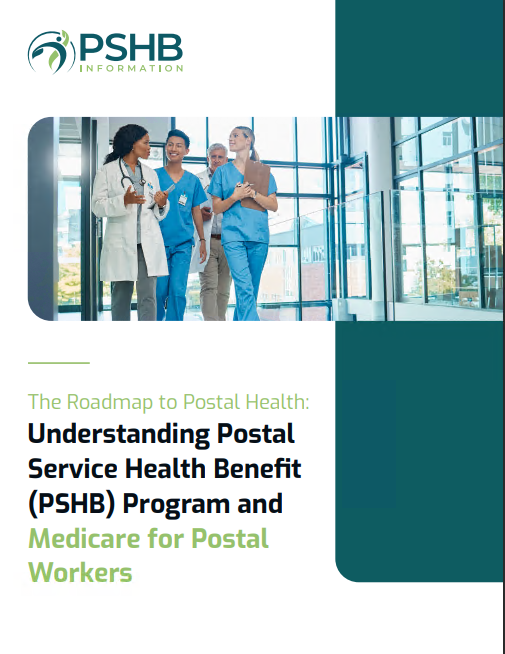Key Takeaways:
- The PSHB program, starting in January 2025, will offer tailored health benefits exclusively for USPS employees, annuitants, and their families.
- Understanding the enrollment process, key dates, and plan options is essential to ensure continuous and comprehensive health coverage.
PSHB Insights: Essential Information for USPS Employees and Retirees on New Health Benefits
The Postal Service Health Benefits (PSHB) Program is poised to bring significant changes to the health benefits landscape for USPS employees, retirees, and their families. This new program, set to begin in 2025, is a critical development in the wake of the Postal Service Reform Act (PSRA). Understanding these changes and preparing for them is vital for all eligible participants.
What’s New with PSHB?
The PSHB Program is a newly established health benefits system specifically designed for USPS employees and annuitants. Unlike the previous Federal Employees Health Benefits (FEHB) Program, PSHB is a standalone program created to address the unique needs of postal workers and their families. This shift is intended to streamline benefits, reduce costs, and provide more tailored health coverage options.
Key features of the PSHB Program include:
- Exclusive Coverage: PSHB will provide health insurance exclusively to USPS employees, retirees, and their eligible family members.
- Medicare Integration: PSHB plans will integrate with Medicare, particularly Medicare Part D for prescription drug coverage, ensuring comprehensive benefits for Medicare-eligible participants.
- Tailored Plans: The plans under PSHB are designed with the specific needs of postal employees in mind, offering better alignment with their healthcare requirements.
Key Dates You Can’t Miss
The transition to PSHB involves several critical dates that all eligible participants must be aware of to ensure they do not miss out on vital coverage:
- Open Season Enrollment: The first opportunity to enroll in a PSHB plan will occur during the Open Season from November 11 to December 9, 2024. This period is crucial for selecting a plan that meets your needs and avoiding automatic enrollment in a default plan.
- Effective Date: Coverage under the PSHB Program will begin on January 1, 2025. It is essential to complete enrollment during the Open Season to ensure continuous coverage.
How PSHB Affects Your Coverage
The transition from FEHB to PSHB will bring about several changes in how health coverage is managed and delivered. Here’s what USPS employees and retirees need to know:
- Plan Options: PSHB will offer a range of health plans that are comparable to those available under FEHB but with features tailored specifically for postal employees. This includes enhanced preventive care, mental health services, and chronic disease management.
- Cost Management: One of the goals of PSHB is to manage healthcare costs more effectively while maintaining high-quality coverage. This means potential changes in premiums and out-of-pocket costs, designed to be more predictable and manageable.
- Medicare Part B Requirement: For Medicare-eligible retirees, enrollment in Medicare Part B will be required to receive PSHB benefits. This integration aims to optimize healthcare delivery and reduce costs.
Switching from FEHB to PSHB: What to Know
Switching from the familiar FEHB Program to the new PSHB might seem daunting, but understanding the key differences and similarities can help make the transition smoother:
- Similar Coverage with Specific Enhancements: While PSHB plans will be similar to current FEHB plans, they will include specific enhancements for postal workers, such as better coordination with Medicare.
- Enrollment Process: The enrollment process during the Open Season in 2024 will be similar to the FEHB process, but with new options and considerations unique to PSHB.
- Automatic Enrollment: If you do not actively select a PSHB plan during Open Season, you will be automatically enrolled in a default plan. It’s important to review and choose a plan that best fits your needs to avoid surprises.
Medicare and PSHB: What’s the Connection?
A significant aspect of the PSHB Program is its integration with Medicare, particularly for retirees. Understanding this connection is crucial for maximizing your benefits:
- Medicare Part D: All PSHB plans will include Medicare Part D prescription drug coverage for eligible participants. This ensures that retirees have access to comprehensive drug coverage, reducing out-of-pocket expenses.
- Medicare Part B Requirement: To be eligible for PSHB benefits, Medicare-eligible retirees must enroll in Medicare Part B. This integration helps optimize overall healthcare delivery and control costs.
Steps to Prepare for PSHB Enrollment
Preparing for the transition to PSHB involves several key steps to ensure you make informed decisions and maintain continuous coverage:
- Stay Informed: Regularly check updates from USPS and the Office of Personnel Management (OPM). Attend informational seminars and review available resources to stay up-to-date with the latest developments and requirements.
- Evaluate Your Options: Use comparison tools and resources provided by USPS to evaluate different health plan options under PSHB. Consider your healthcare needs and budget when selecting a plan.
- Understand Medicare Requirements: If you are eligible for Medicare, familiarize yourself with the requirements for integrating Medicare Part B and Part D with your PSHB plan to ensure comprehensive coverage.
- Enroll During Open Season: Make sure to enroll in a PSHB plan during the Open Season from November 11 to December 9, 2024. This ensures you have a plan that meets your needs and avoids automatic enrollment in a default plan.
Common Questions About PSHB Answered
As USPS employees and retirees prepare for the transition to PSHB, several common questions arise. Here are some answers to help clarify the changes:
- What Happens If I Don’t Enroll?: If you do not enroll during the Open Season, you will be automatically assigned to a default PSHB plan. It’s crucial to actively select a plan to ensure it meets your specific needs.
- Will My Current Doctors Be Covered?: The network of providers under PSHB plans is expected to be similar to those under FEHB. However, it’s important to verify that your current doctors and preferred healthcare providers are included in the network of the plan you choose.
- How Will My Prescription Coverage Change?: PSHB plans will include Medicare Part D prescription drug coverage for eligible participants, which should enhance your current prescription benefits and potentially reduce out-of-pocket costs.
Staying Informed: Resources and Updates
Keeping up-to-date with the latest information about PSHB is crucial for a smooth transition. Here are some ways to stay informed:
- Official USPS and OPM Websites: Regularly visit the USPS and OPM websites for the latest updates, FAQs, and resources related to the PSHB Program.
- Informational Seminars: Attend informational seminars hosted by USPS and OPM. These seminars provide valuable insights into the PSHB Program and the enrollment process.
- Comparison Tools: Utilize online tools like the Medicare Part B Comparison Tool to evaluate how different PSHB plans align with your healthcare needs and budget.
- Communication Channels: Sign up for email updates and text message alerts from USPS to receive timely information about important dates, changes, and requirements.
Conclusion: Navigating the Transition to PSHB
The transition to the PSHB Program marks a significant change in health benefits for USPS employees and retirees. By staying informed, evaluating your options carefully, and understanding the enrollment process, you can ensure that you and your family receive the best possible coverage under the new system. The PSHB Program aims to provide comprehensive and cost-effective health benefits tailored to the unique needs of the postal community, making this transition an opportunity for improved healthcare management.
As the Open Season approaches, take proactive steps to review your health plan options, attend informational sessions, and utilize available resources to make informed decisions. Ensuring a smooth transition to PSHB will pave the way for better health and well-being for all USPS employees, retirees, and their families.
Contact Information:
Email: [email protected]
Phone: 3615551234






